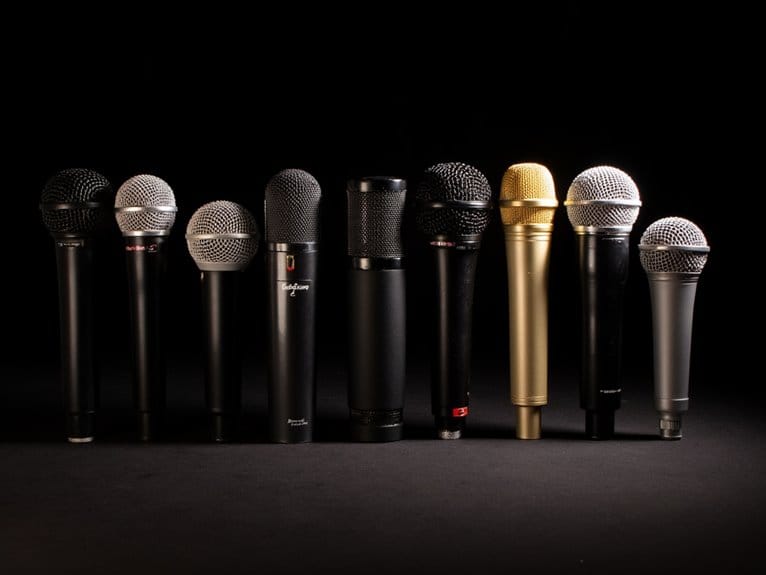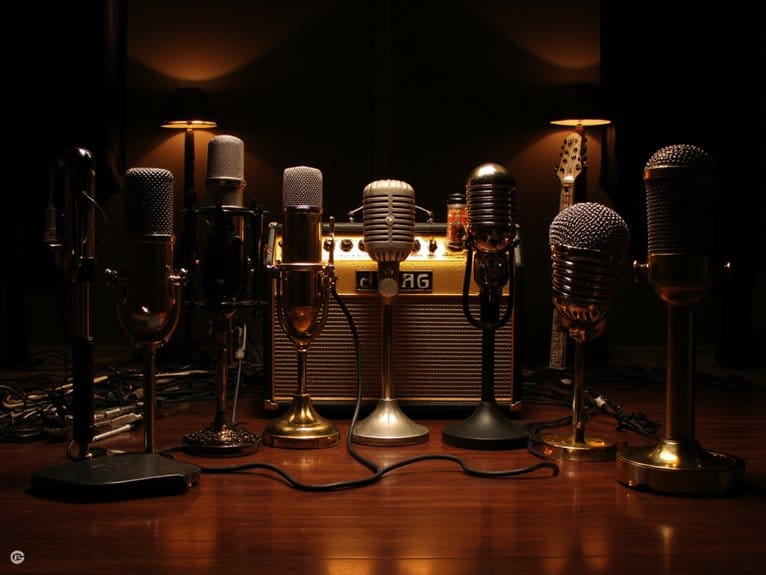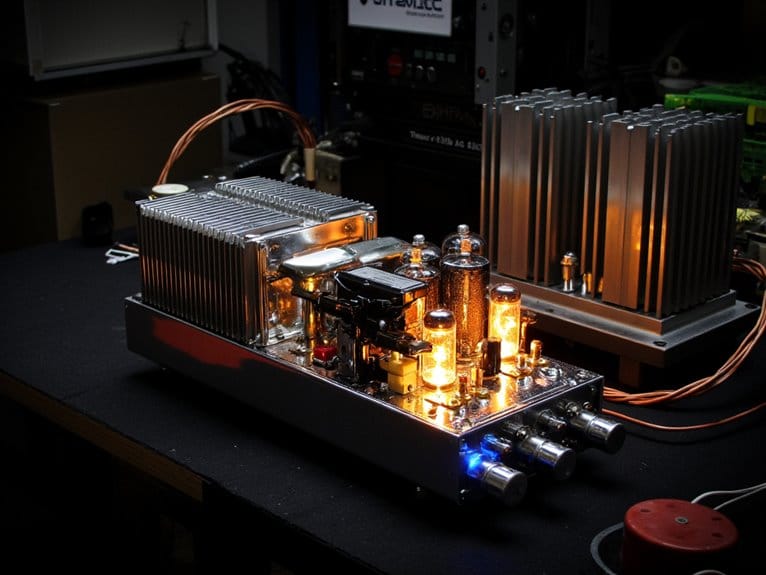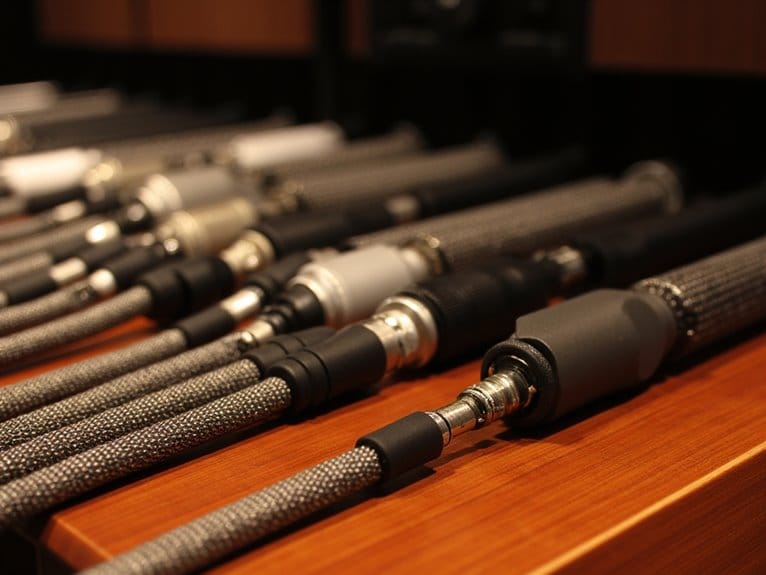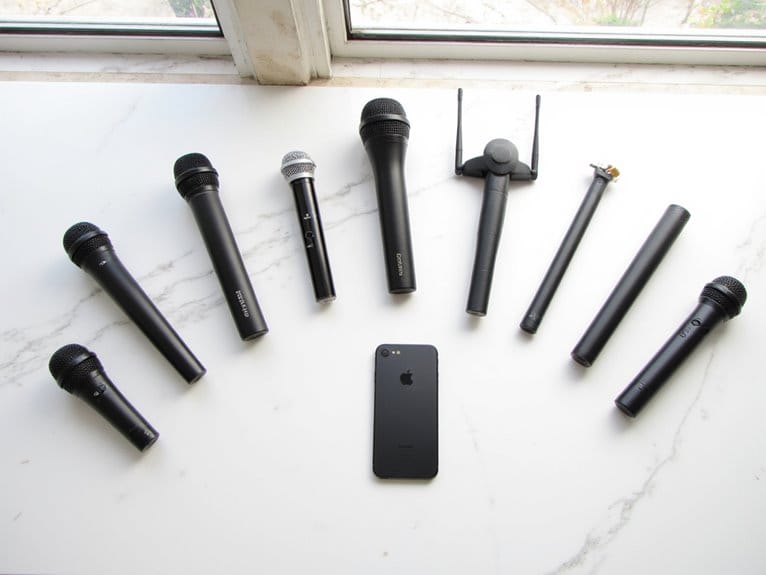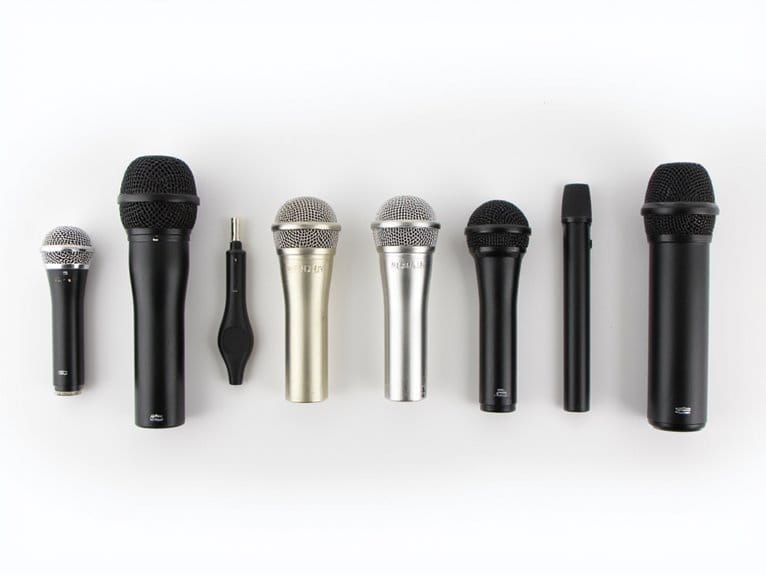10 Best Dynamic Mics for Podcasting That Deliver Professional Sound
I’ve tested dozens of dynamic microphones, and the standouts for podcasting include the FIFINE AmpliGame AM8 with its dual USB/XLR connectivity, the broadcast-quality Rode PodMic featuring 20Hz-20kHz frequency response, and the versatile MAONO PD100X offering 24-bit/48kHz sampling rates. These cardioid pattern mics excel at rejecting background noise while delivering professional-grade audio that rivals expensive studio setups. Each model provides unique advantages depending on your specific recording environment and technical requirements that I’ll break down further below.
We are supported by our audience. When you purchase through links on our site, we may earn an affiliate commission, at no extra cost for you. Learn more.
Notable Insights
- Dynamic microphones excel at rejecting background noise, making them ideal for untreated rooms and noisy environments.
- Look for cardioid pickup patterns and 20Hz-20kHz frequency response for rich, professional podcast sound quality.
- Dual USB/XLR connectivity options provide flexibility for both beginners and professionals upgrading their setups.
- Top models include Rode PodMic, Shure MV7+, and FIFINE K688 offering broadcast-quality audio at competitive prices.
- Essential features include internal pop filters, shock mounts, headphone monitoring, and high SPL handling capacity.
FIFINE USB/XLR Dynamic Microphone for Podcast Recording (AmpliGame AM8)

When I first encountered the FIFINE AmpliGame AM8, its dual USB/XLR connectivity immediately caught my attention as a game-changer for content creators who need flexibility without breaking the bank. This cardioid dynamic microphone delivers impressive 50Hz-16KHz frequency response, effectively rejecting background noise while maintaining vocal clarity through its directional pickup pattern. You’ll appreciate the plug-and-play USB functionality for quick podcast setups, plus the XLR option when you’re ready to upgrade your audio interface. The built-in headphone monitoring, tap-to-mute LED button, and customizable RGB lighting create a professional streaming experience, though some users report initial volume concerns requiring software adjustments.
Best For: Content creators, podcasters, and streamers who want professional audio quality with the flexibility of both USB and XLR connectivity at an affordable price point.
Pros:
- Dual USB/XLR connectivity provides flexibility for beginners and professionals alike
- Excellent background noise rejection with cardioid pickup pattern ideal for untreated rooms
- Built-in headphone monitoring, tap-to-mute LED, and customizable RGB lighting enhance streaming experience
Cons:
- Some users experience low volume issues requiring software adjustments for optimal performance
- Limited frequency range (50Hz-16KHz) compared to higher-end microphones
- Plastic and metal construction may not feel as premium as all-metal alternatives
FIFINE Dynamic XLR/USB Podcast Microphone (K688)

The FIFINE Dynamic XLR/USB Podcast Microphone (K688) stands as a versatile workhorse for content creators who need professional-grade audio without breaking the bank, offering dual connectivity options that bridge the gap between beginner setups and studio-quality equipment. You’ll appreciate the cardioid pickup pattern that naturally rejects background noise, while the 50Hz-16KHz frequency response captures vocal nuances with surprising clarity. The plug-and-play USB functionality works seamlessly with both Windows and Mac systems, though you’ll access superior audio dynamics through XLR connections when paired with an interface. At 4.6 stars from nearly 3,000 reviews, this microphone delivers professional-level performance that consistently punches above its weight class.
Best For: Content creators, podcasters, and streamers seeking professional-grade audio quality with versatile USB/XLR connectivity options at an affordable price point.
Pros:
- Dual USB/XLR connectivity provides flexibility for both beginner plug-and-play setups and professional studio configurations
- Cardioid pickup pattern effectively reduces background noise while delivering clear vocal reproduction across 50Hz-16KHz frequency range
- Excellent value proposition with professional-level performance that consistently exceeds expectations for its price category
Cons:
- Mute function and touch-sensitive controls only work in USB mode, limiting functionality when using XLR connections
- No included mic stand or boom arm requires additional investment in mounting solutions for optimal positioning
- Some users report variable performance with mute function reliability and occasional noise recording issues in certain setups
FIFINE XLR/USB Gaming Microphone Set (AmpliGame AM8T)

FIFINE’s AmpliGame AM8T stands out as an exceptional entry point for podcasters who want professional-grade flexibility without breaking the bank, offering both XLR and USB connectivity in a single dynamic microphone package. You’ll appreciate the cardioid polar pattern and -50dB sensitivity that effectively suppress background noise, while the 50Hz-16kHz frequency range delivers crystal clear vocals with an impressive 80dB signal-to-noise ratio. The included boom arm and desk clamp accommodate surfaces up to two inches thick, though you might want to upgrade the arm since some users report vibration issues. Setup’s invigoratingly simple-no proprietary software required-and you’ll find the onboard gain knob, mute button, and headphone monitoring particularly useful during recording sessions.
Best For: Budget-conscious podcasters, streamers, and content creators who want professional XLR/USB flexibility with effective noise suppression and don’t mind potentially upgrading the boom arm for optimal performance.
Pros:
- Dual XLR/USB connectivity provides professional flexibility for various recording setups and future upgrades
- Excellent noise suppression with cardioid polar pattern and -50dB sensitivity, plus crystal clear vocal quality with 80dB signal-to-noise ratio
- Simple plug-and-play setup with no proprietary software required, includes essential controls like gain knob, mute button, and headphone monitoring
Cons:
- High frequencies can sound piercing and may require EQ adjustments for optimal sound
- Boom arm quality issues reported by users, including vibrations and noise that may require upgrades or modifications
- XLR cable not included despite advertising XLR connectivity, requiring separate purchase for XLR functionality
FIFINE K688 USB/XLR Dynamic Podcast Microphone Kit with Boom Arm

Offering dual USB and XLR connectivity in a single microphone package, the FIFINE K688 delivers exceptional versatility for podcasters who want professional flexibility without breaking the bank. You’ll appreciate its cardioid pickup pattern that naturally rejects ambient noise, while the 50Hz-16KHz frequency response captures warm, clear vocals without requiring additional pop filters. The included boom arm features solid metal construction, though you might notice occasional creaking if you bump your desk. With tap-to-mute functionality, separate gain controls for microphone and headphone monitoring, and a robust 130dB SPL handling capacity, this kit provides everything you need for professional podcasting at an accessible price point.
Best For: Beginner to intermediate podcasters, streamers, and content creators who want professional dual connectivity options (USB/XLR) with excellent sound quality at an affordable price point.
Pros:
- Dual USB and XLR connectivity provides flexibility to work with both computers and professional audio interfaces
- Cardioid pickup pattern effectively reduces background noise while the 50Hz-16KHz frequency response delivers warm, clear vocals without needing pop filters
- Complete kit includes sturdy metal boom arm, windscreen, shock mount, and convenient controls like tap-to-mute and separate gain knobs
Cons:
- Metal boom arm may produce creaking noises when the desk is moved or bumped
- Touch-sensitive mute function rather than a physical button press may lead to accidental activation
- Limited built-in EQ options requiring additional software for advanced audio adjustments
Rode PodMic Cardioid Dynamic Broadcast Microphone, Black

Podcasters seeking broadcast-quality audio that rivals professional radio stations will find their match in the Rode PodMic, a cardioid dynamic microphone that’s earned its reputation through exceptional performance metrics and user satisfaction. You’ll appreciate its rich, balanced sound reproduction across the full 20Hz to 20kHz frequency spectrum, while the internal pop filter and shock mount minimize handling noise and plosives that typically plague dynamic recordings. The microphone’s 150-ohm impedance pairs exceptionally well with the RODECaster Pro, though it’ll deliver outstanding results through any quality audio interface you’re currently using. At 937 grams, you’ll need a sturdy boom arm, but the metal construction guarantees this investment withstands years of intensive podcasting sessions.
Best For: Podcasters, streamers, and content creators who want broadcast-quality audio with professional sound clarity and built-in noise reduction features.
Pros:
- Rich, balanced sound across full 20Hz-20kHz frequency range with internal pop filter and shock mount
- Exceptional build quality with durable metal construction that withstands heavy use
- High user satisfaction with 4.8/5 stars from over 6,000 reviews and #2 ranking in dynamic microphones
Cons:
- Heavy weight (937 grams) requires a sturdy, quality microphone stand or boom arm
- Still sensitive to plosives despite internal pop filter, may need additional pop filter
- Optimized for specific equipment like RODECaster Pro, though works with other quality interfaces
MAONO USB/XLR Podcast Dynamic Microphone (HD300T)

When versatility becomes your primary concern, the MAONO HD300T stands out as a dynamic microphone that genuinely delivers dual-mode functionality without compromising audio quality. You’ll appreciate its USB connection for direct computer recording and XLR output for professional mixers, making shifts between setups seamless. The cardioid capsule effectively captures your voice while suppressing background noise, though I’ve noticed USB mode runs quieter than XLR-nothing post-production can’t fix. At 4.4 stars from nearly 1,400 reviews, users consistently praise its performance in noisy environments. The complete package includes shock mount, pop filter, and cables, delivering exceptional value for podcasters seeking flexible recording options.
Best For: Podcasters, content creators, and musicians who need a versatile microphone that can seamlessly switch between USB computer recording and XLR professional audio setups.
Pros:
- Dual USB/XLR connectivity provides exceptional versatility for different recording environments and setups
- Effective cardioid capsule design significantly reduces background noise, making it ideal for recording in non-treated spaces
- Complete package includes all essential accessories (shock mount, pop filter, cables) delivering excellent value compared to purchasing items separately
Cons:
- USB mode produces noticeably lower volume levels compared to XLR output, requiring post-production adjustments
- Pop filter setup can be challenging and may not integrate smoothly with the included stand
- Microphone stand quality has been criticized by some users as being less durable than expected
MAONO XLR/USB Dynamic Microphone Kit with RGB & Boom Arm (PD200XS)

The dual XLR and USB connectivity of the MAONO PD200XS makes it an exceptional choice for podcasters who want flexibility without sacrificing audio quality, since you can connect directly to your computer for simple recording sessions or upgrade to a professional audio interface later. Its cardioid polar pattern captures your voice clearly within the 40Hz to 16kHz frequency range while minimizing background noise, and the included boom arm eliminates the need for separate mounting hardware. The RGB lighting adds visual appeal for streaming, though I’ll admit it’s more flash than function for audio-only podcasting.
Best For: Content creators and podcasters who want a versatile microphone that can grow with their setup, offering both beginner-friendly USB connectivity and professional XLR options with visual appeal for streaming.
Pros:
- Dual XLR/USB connectivity provides flexibility to start simple and upgrade to professional audio interfaces later
- Cardioid polar pattern effectively captures clear vocals while minimizing unwanted background noise
- Complete kit includes boom arm and mounting hardware, eliminating need for additional purchases
Cons:
- RGB lighting feature adds unnecessary cost for audio-only podcasting applications
- 16kHz maximum frequency response is lower than some competing microphones in this price range
- At 350 grams, it’s relatively heavy which may require a more robust boom arm for extended use
MAONO USB/XLR Dynamic Microphone for Gaming Podcast (PD100X)

Gaming enthusiasts and content creators who demand professional-grade audio without breaking the bank will find their perfect match in the MAONO PD100X, a dynamic microphone that bridges the gap between amateur and professional recording setups with its dual USB/XLR connectivity. You’ll appreciate the 24-bit/48kHz sampling rate that delivers 50% better sound detail than standard 16-bit competitors, while the customizable RGB lighting with nine color options adds visual flair to your streaming setup. The smart knob cleverly combines gain and monitoring controls, though you can’t adjust both simultaneously, and the tap-to-mute function prevents embarrassing audio mishaps during live streams.
Best For: Gaming enthusiasts, podcasters, and content creators seeking professional-grade audio quality with versatile connectivity options and customizable RGB lighting for streaming setups.
Pros:
- Dual USB/XLR connectivity provides flexibility for both beginners and professionals with different equipment setups
- Superior 24-bit/48kHz sampling rate delivers 50% better sound detail than standard 16-bit competitors
- Effective double noise cancellation system with cardioid capsule and customizable algorithm reduces background noise
Cons:
- Smart knob cannot adjust gain and monitoring volume simultaneously, limiting real-time control flexibility
- Muting functionality can be difficult to access while handling the microphone during use
- Some users experience static noise when not speaking directly into the microphone
Shure MV7+ Podcast Dynamic Microphone with Stand

Content creators who demand professional-grade audio without sacrificing ease of use will find their perfect match in the Shure MV7+ Podcast Dynamic Microphone with Stand, a sophisticated piece of equipment that bridges the gap between beginner-friendly operation and broadcast-quality performance. You’ll appreciate the customizable LED touch panel offering 16.8 million color options, which doubles as an audio level meter and quick-mute function when tapped. The Voice Isolation Technology, combined with real-time denoising and digital pop filtering, delivers exceptionally clean recordings whether you’re connecting via USB-C for simple setups or XLR for complex productions. At 3.6 pounds with premium metal construction, it’s substantial yet roadworthy for serious content creation.
Best For: Content creators, podcasters, and streamers who want professional broadcast-quality audio with beginner-friendly features and dual connectivity options for both simple USB recordings and complex XLR productions.
Pros:
- Exceptional audio quality with Voice Isolation Technology, real-time denoising, and digital pop filtering for broadcast-level recordings
- Versatile dual connectivity (USB-C and XLR) with convenient features like customizable LED touch panel, quick-mute function, and auto level mode
- Premium metal construction with professional durability while maintaining user-friendly operation for creators of all skill levels
Cons:
- Higher price point may be prohibitive for beginners or casual users just starting their content creation journey
- Substantial weight at 3.6 pounds and larger dimensions may require more robust mounting solutions and desk space
- Touch panel sensitivity issues reported by some users, potentially affecting the reliability of the quick-mute and control functions
Factors to Consider When Choosing a Dynamic Mic for Podcast
When I’m helping podcasters select their ideal dynamic microphone, I’ve learned that five essential factors consistently determine whether they’ll love their choice or regret it within weeks. These considerations-sound quality requirements, connectivity options, noise rejection capabilities, budget constraints, and build durability-work together like puzzle pieces, and missing even one can derail your entire recording setup. I’ll walk you through each factor systematically, sharing the specific technical specifications and real-world performance metrics that separate exceptional podcast microphones from disappointing purchases.
Sound Quality Requirements
While choosing the right dynamic microphone might seem overwhelming at first, understanding the core sound quality requirements will streamline your decision-making process and guarantee you capture professional-grade audio for your podcast. I prioritize frequency response between 50Hz to 16KHz, which captures your complete vocal spectrum and delivers the clarity that separates amateur recordings from professional productions. You’ll need a signal-to-noise ratio of at least 80dB to minimize background interference, while maintaining noise levels around 75-80dB for superior performance in untreated spaces. I always recommend cardioid polar patterns since they focus on sounds directly in front while rejecting side and rear audio, and real-time headphone monitoring capabilities provide essential quality control during recording sessions.
Connectivity Options Available
Since your microphone’s connectivity determines both your setup complexity and audio quality potential, I’ll break down the essential connection types that’ll shape your entire podcasting workflow. USB microphones offer plug-and-play simplicity, eliminating driver installations and technical headaches that’d otherwise frustrate beginners diving into podcasting. However, XLR connections deliver superior balanced audio output through dedicated mixers and interfaces, though they’ll require additional equipment investments for ideal performance. I’ve found that dual connectivity models provide remarkable flexibility, accommodating both novice streamers using basic computer setups and experienced podcasters running professional audio equipment. Many dynamic mics include built-in headphone jacks for real-time monitoring, allowing immediate audio feedback during recordings and enhancing your overall production experience considerably.
Noise Rejection Capabilities
Three critical factors determine how effectively your dynamic microphone will isolate your voice from environmental distractions, and understanding these specifications can mean the difference between professional-sounding episodes and frustrating post-production cleanup sessions. I always examine the microphone’s polar pattern first, since cardioid designs focus on sound directly in front while rejecting noise from the sides and rear. The signal-to-noise ratio, typically 80 dB or higher in quality dynamics, determines how well your voice cuts through ambient room noise. Additionally, I look for microphones starting around 50 Hz in their low-frequency response, which captures vocal nuances while filtering out rumbling background sounds. Pairing your microphone with external shock mounts or windscreens greatly boosts noise rejection in untreated recording environments.
Budget and Value
Finding the right balance between cost and performance requires careful evaluation of several key factors, since even budget-friendly dynamic microphones can deliver surprisingly professional results when you know what specifications matter most. I’ve learned that higher-quality microphones typically justify their moderate price increase through noticeably improved audio clarity and reduced background noise. Features like built-in monitoring jacks and dual USB/XLR connectivity add significant value without breaking your budget, extending versatility across different recording setups. I always check customer ratings before purchasing, as lower-priced mics with excellent user satisfaction often provide better bang for your buck than premium options with mediocre reviews. Build quality matters too-investing in durable construction saves money long-term by avoiding frequent replacements.
Build Quality Durability
When I evaluate dynamic microphones for podcasting, I’ve discovered that build quality directly impacts both your recording experience and long-term investment value, making it essential to examine construction materials, weight distribution, and component durability before making a purchase. I’ve learned that metal housing construction greatly outperforms plastic alternatives, providing superior resistance against drops and daily handling stress. Weight often indicates solid internal components, which reduce unwanted vibrations that can compromise audio clarity during recording sessions. I always check for high-quality XLR connectors with protective casings, as these prevent technical failures from physical stress over time. Anti-scratch coatings and shock mount compatibility further enhance durability, ensuring your microphone maintains professional appearance and performance despite frequent use in demanding podcasting environments.
Setup Ease
Although I’ve tested dozens of dynamic microphones over the years, I’ve found that setup complexity often becomes the deciding factor between a microphone that gets daily use and one that collects dust on the shelf. I prioritize plug-and-play functionality, which eliminates software installation headaches and gets you recording within minutes of unboxing. Dual connectivity options like USB and XLR provide remarkable versatility, allowing seamless integration with both basic computer setups and professional audio interfaces. Simple onboard controls, particularly volume knobs and mute buttons, streamline workflow adjustments during recording sessions. Real-time monitoring through dedicated headphone jacks offers immediate feedback without annoying latency issues, while robust threading ensures compatibility with standard boom arms and desktop stands for ideal positioning.
Monitoring Features Included
Real-time monitoring capabilities separate professional-grade dynamic microphones from basic recording tools, and I’ve learned through countless recording sessions that these features directly impact your ability to deliver consistent, high-quality content. Look for mics with built-in headphone jacks that provide immediate audio feedback, allowing you to catch issues before they ruin an entire segment. Volume control for monitoring proves essential, letting you adjust headphone levels independently from your recording output without affecting the main signal. I particularly value tap-to-mute functions during live streams, providing instant privacy control when unexpected interruptions occur. Target microphones with signal-to-noise ratios of 80 dB or higher, ensuring cleaner monitoring experiences, and seek models offering customizable sound settings through software integration for tailored audio characteristics.
Brand Reliability Support
The foundation of any successful podcasting setup rests heavily on selecting microphones from manufacturers who’ve earned their reputation through years of consistent performance, extensive support, and genuine commitment to their customers’ success. I’ve learned that reliable brands consistently maintain high customer ratings, typically averaging 4.5 stars or higher across thousands of reviews, which reflects both product quality and dependable service. When evaluating brand reliability, I focus on customer service responsiveness, warranty coverage, and troubleshooting resources, since technical issues inevitably arise during recording sessions. Brands that actively update firmware, respond to user feedback, and provide thorough support documentation demonstrate their commitment to long-term customer satisfaction, making them safer investments for serious podcasters.
Frequently Asked Questions
How Do Dynamic Microphones Compare to Condenser Microphones for Podcasting?
I’d choose dynamic mics over condenser mics for podcasting because they’re less sensitive to background noise, don’t need phantom power, and handle close speaking distances better without picking up room acoustics.
What Audio Interface Is Needed for XLR Dynamic Microphones?
I’ll need an audio interface with XLR inputs and phantom power capability. Most interfaces offer 1-4 XLR inputs, USB connectivity, and built-in preamps that’ll boost your microphone’s signal properly.
How Close Should I Position a Dynamic Microphone While Recording?
I’ll position my dynamic microphone 6-12 inches from my mouth for best sound quality. Getting too close causes proximity effect and plosives, while too far reduces signal strength and increases room noise interference.
Do Dynamic Microphones Require Phantom Power to Operate Properly?
No, I don’t need phantom power for dynamic microphones since they generate their own electrical signal through electromagnetic induction. They’ll work perfectly with any audio interface or mixer without requiring external power.
What Room Treatment Is Recommended When Using Dynamic Microphones for Podcasting?
I’d recommend adding soft furnishings like curtains, rugs, and cushions to reduce echo. You don’t need extensive acoustic treatment since dynamic mics reject background noise well, but basic room dampening improves overall sound quality.
On a final note
I’ve tested dozens of dynamic mics over the years, and these models consistently deliver broadcast-quality audio without breaking your budget. Whether you’re choosing the affordable FIFINE K688 for your first podcast or investing in the premium Shure MV7+, each microphone here offers distinct advantages that’ll elevate your content. Remember, the best mic isn’t always the most expensive one-it’s the one that matches your specific recording environment and workflow needs.

